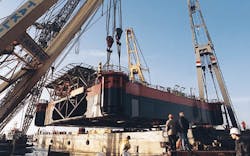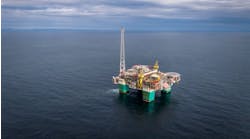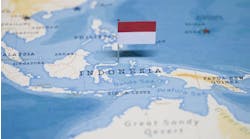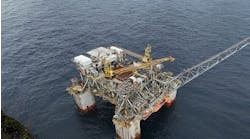Four sheerlegs cranes operated by Takmarine, a Smit International company, were recently employed to lift the 1,200 tonne pontoon for Clyde's P6 South production jack-up into the water, at the Hollandia yard near Rotterdam. It was then towed to Europoort's Petroleum Harbour No.8 in readiness for assembly of the jack-up's four, 65m long legs.Dutch designers and fabricators are under pressure from ever tighter project schedules. In their march towards shorter lead times to production, operators expect contractors to be adapt quickly and easily to the changing market needs.
A typical example of a fast-track Dutch sector project was Elf Petroland's L7-H Southeast gas development. Production from this field started last July at 2mcm/d, only seven weeks after the exploration well L7-15 had been completed. The well was deviated from the L7-H platform.
This was Elf Petroland's second swift gasfield development following J3-a Charlie, a small gas pocket encountered through a deviated well drilled from Lasmo's Markham platform in block J6 into the adjacent block J3a. This was brought onstream within three months. "These two examples demonstrate our policy of creating a return on investments as fast as possible," commented the operator. A new gas discovery close to J3a-C, K1-3, will be developed this year using the same procedure.
In addition to Elf Petroland's wells, Occidental (L11a-2) and Wintershall (K10a-15) also brought satellite gasfields onstream last year. In all four cases, the discovery wells were recompleted into production wells, a more or less standard procedure of late on the Dutch shelf. This method cuts drilling costs of new developments and shortens the time between the development decision and the field start-up.
Operators are now searching for new ways of cutting development time. A typical instance is NAM's K14-FB gas production platform, which is constructed according to what NAM calls the cut-and-paste principle. The design incorporates features from four recent NAM satellite platforms as well as other operators' installations.
K14-FB is a small gasfield discovered 20 years ago. Recently acquired 3D seismic suggests reserves may be double the initial 141 bcf estimate. Development was initiated in April 1996, with Heerema Fabrication Group awarded the construction contract last June. Total costs will be around $100 million, including the wells, with the field due onstream this October - a tight construction period given the suspected size of the reserves. But despite the speed of the schedule, safety and other operational aspects will not be compromised, NAM claims.
The new platform will export 79 mcf/d to the existing K14-FA production platform through a 10 km, 10-in. duplex stainless steel pipeline. This host facility will be equipped with a 220-ton module containing a slug catcher separator. Otherwise existing gas drying facilities should be capable of treating the extra gasflow.
Clyde, too, has demonstrated an unconventional approach towards new field development by selecting small engineering and contracting firms that are willing to devote themselves to one or two clients over a limited period. For the P2/P6 gas development Clyde selected companies such as KCI Engineering and Vageri E&L which have only marginal overhead costs and can therefore respond quickly and flexibly.
Exploration up
The general upturn on the Dutch shelf during 1996 was reflected in a surge of exploration and appraisal from only 11 offshore wells in 1995 to 27 completions last year. NAM was the most active operator with seven offshore wells in 1996. Elf Petroland completed six wells, Occidental four, Amoco, Wintershall and PanCanadian two each, and Clyde, Conoco, Lasmo and RWE-DEA one well each.Gas discoveries last year included K4-9b, E12-4 and L7-15 (Elf Petroland), K7-9, K7-10 and E17-2 (NAM), L11-A2, L10-31 and K9-8 (Occidental) and M7-5 (Clyde). According to figures from analyst Wood Mackenzie, these new finds added 1,165 tcf to the Dutch reserves base. Of the 22 companies involved in exploration, NAM gained the largest share, followed by Mobil and Elf. Success rate in exploration drilling offshore was 58%.
Production of gas offshore The Netherlands reached 953 bcf last year, some 81 bcf up on 1995. The increase derived primarily from higher yields from fields such as Unocal's Halfweg and NAM's K11-FB and L13-FH, which attained peak output.
New developments
The Dutch North Sea should also add a new oilfield development shortly following a commercial find by German operator RWE-DEA with well F2-5. The field is thought to contain around 40MM bbl and could be developed commercially if tied back to NAM's F3 oil and gas production platform. In that case, it could be producing by 2000. This February, RWE-DEA announced it would drill two new wells in the area using the rig Neddrill 3.Dutch offshore oil production is expected to decline rapidly when the Kotter and Logger Fields reach their economic threshold at the end of this year. Operator Conoco announced that both platforms will be laid down at that time unless a potential buyer is found that would want to keep them functioning optimally until their relocation.
In the meantime, most exploration drilling, and therefore most new developments, are to be found near existing infrastructure. The single major development in a virgin area is NAM's L9 gas project situated 20 km east of the Nogat trunkline. Production start-up is planned for early 1998. Clyde is expected to initiate production from its three new platforms in P2 and P6 over the next few months.
Elf Petroland successfully drilled appraisal well K6-11 into the K6-G gas structure, after which it decided to develop the field in combination with the K6-T structure. First gas is due next year. Also in 1998, the new K4-A installation is expected onstream with L4-PN following in 1999. A new gas discovery in well K4-10 last November further increased the area's promise.
This year, K5-EN/C, currently under construction at Mercon, will be installed and commissioned. The small K4-D Field will be developed as a subsea satellite tied back to Lasmo's Markham platform.
It will be interesting to see what NAM and Wintershall devise for their gas accumulations in blocks D12 and D15, 50 km north of Markham. Production licenses were awarded last year.
During the planning phase of the Nogat pipeline in 1988, it was regularly speculated that a western extension of the northerly trunkline, Wogat, could be constructed to open up the D and E blocks. A tie-back towards existing infrastructure in the K and L blocks, where production from mature fields is plummeting, seems more realistic from an economic point of view.
Copyright 1997 Oil & Gas Journal. All Rights Reserved.



